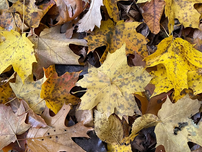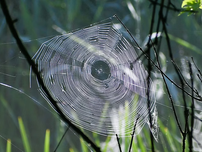top of page
All Posts


Fast fact: Woolly bear caterpillars
Woolly bear caterpillars, which grow into Isabella tiger moths, are often thought to predict winter based on their brown band size. However, band size is actually linked to age and diet. While they can’t forecast weather, they do have a cool survival trick. They produce glycerol, a natural antifreeze, that protects their cells when they freeze in winter, helping them survive extreme cold.


Fast fact: Acorns
Acorns are in high demand in fall as animals like squirrels, deer, chipmunks, and birds stock up for winter. Acorns are oak tree seeds, with a smooth seed and a rough “hat” called a cupule. Oak trees don’t produce the same number each year—mast years bring many more acorns, sometimes up to 10,000 per tree, occurring every two to five years for reasons scientists still study.


Fast fact: Wolf spiders
Wolf spiders may look scary, but they aren’t dangerous to humans. They’re not aggressive, and their bites aren’t harmful. There are 2,000 to 3,000 wolf spider species worldwide, with 47 in Illinois. Female wolf spiders carry their egg sacs, then let the babies climb onto their backs after hatching, giving them a ride until they’re ready to live on their own.


When the leaves fall, squirrels' homes are revealed
As leaves fall, look for messy clumps in trees - these are squirrel nests, or dreys. Built from twigs, leaves, and moss, dreys are sturdy, often waterproof homes about 30 feet up. Inside, they’re lined with dry grasses, leaves and bark, however, paper and plastic litter can also be found. Squirrels make several dreys at a time and abandon it after one to two years of use. Some use tree cavities in the winter.


Fast facts: Fall color
The bright fall colors we love have been in leaves all along, but chlorophyll, which makes leaves green, hides them during spring and summer. As days get shorter in fall, chlorophyll breaks down, revealing pigments like xanthophylls (yellow), carotenoids (orange), and anthocyanins (red). These pigments create the vibrant autumn colors we enjoy each year.


Fast facts: Lady beetles
-What we call ladybugs are actually lady beetles because beetles and bugs are different insect orders. Illinois has many species, both native and non-native. Native lady beetles help by eating garden pests, while non-native ones, like the Asian lady beetle, can be invasive and bite. Lady beetles are known for their spots, which vary in number. Not all lady beetles have spots, and not all are female despite their name.


Learn to read the stories our trees are telling us
A pair of light and dark tree rings equals one year of growth. Wider rings suggest good climate conditions that year and thin rings suggest otherwise. Fire scars, broken branches, and leaning can also be seen in the patterns. The dark center (heartwood) is old and strong, and the outer rings are the youngest. To estimate a living tree’s age, measure its trunk 5 feet up - each inch of circumference equals about one year. By reading tree rings, we learn both the tree’s past and


Fast fact: Owl pellets
Owl pellets are not poop but regurgitated bits of undigested food like bones, fur, and feathers. Owls swallow prey whole and can’t digest those parts, so they form a pellet in their gizzard and spit it out. Found under roosting spots, pellets can show what owls have eaten. If you dissect one, wear gloves. Other birds like hawks and herons also produce pellets.


Hairy wolf spiders live up to their name
Wolf spiders are fast, hairy hunters found worldwide except Antarctica. Their drab colors blend in with nature and protect them from predators. Named for their wolf-like traits, wolf spiders don’t spin webs but chase or ambush prey at night, using eight eyes and reflective eyeshine for vision. Females carry their egg sacs and young on their backs. They can live anywhere, but will most likely be found in lawns, under leaves, and rocks. Wolf spiders are fascinating and closer t


Fast fact: Red-tailed hawks
Red-tailed hawks are common North American raptors known for sharp talons, keen eyesight, and hooked beaks. They mainly eat small mammals like mice and rabbits but can catch prey up to 5 pounds. Adaptable to many habitats, they live in deserts, rainforests, woodlands, and grasslands. In Illinois, they are found in both rural and urban areas, often seen soaring or perched while hunting.


See a bird looking a little funny? It's likely molting
Feathers are made of keratin and get damaged from flying, normal wear and tear, parasites and sun exposure. Since feathers cannot heal themselves, birds molt, shedding its feathers to make way for a new, healthy set. Birds can undergo complete molts - replacing all feathers at once - or partial molts - replacing some feathers with time). Molting requires a lot of energy and can affect the flying ability of some birds. birds can molt once to twice a year either completely, par


Five wild facts about oh-so-common garter snakes
Named for their stripes, the nonvenomous common garter snake, Thamnophis sirtalis, and all of its subspecies, are the most widespread snake across the United States as they are very adaptable and can survive in extreme temperatures. They prefer grassy, moist habitats. Garter snakes can have as many as 80 babies who are fully independent at birth. All snakes are carnivores and rely on their keen senses of smell and vision to hunt. Garter snakes not only slither but can also sw


Bluegills are adapted for success in our waterways
Bluegills are small freshwater fish found throughout Illinois and are the state fish. Their fins give them speed and agility to escape predators and catch prey. They hide in plants and logs, use sharp dorsal spines for defense, and detect water vibrations to sense danger or food. With good eyesight and a special throat suction, they eat insects, larvae and small fish. Despite their size, bluegills thrive thanks to smart adaptations.


Queen Anne’s lace vs. poison hemlock: poison or not?
The Queen Anne’s lace, also known as wild carrot, has many mimics including its poisonous close relative, the poison hemlock. Both are part of the Apiaceae family and require attention to detail to tell them apart. Queen Anne’s lace has more of a flat top, a small purple flower in the center, fuzzy leaves and stem, and can curl upwards as the flowers ripen. A poison hemlock is more rounded, does not have a purple flower at its center, has a smooth stem and leaves, and does no


Fast fact: Bobcats
Bobcats live across Illinois, mostly in the southern half, after recovering from near elimination. They are nocturnal and rarely seen. About twice the size of house cats, bobcats have short, bobbed tails and tufts of fur on their ears. They are skilled hunters, stalking and pouncing on small animals like rodents, rabbits, and birds, biting their prey in the neck to catch it.


Fast Fact: Spider Silk
All spiders make silk, but most do not use it to spin webs. Many use it to build nests, wrap prey, create cocoons, or help them move. Some even produce different silks for different tasks. Spider silk is stronger than any other natural or man made fiber because of its unique protein structure. Scientists are working to develop a man made version with the same strength and flexibility.


Little lobsters? Crayfish are a close relative
Tiny crayfish, also known as crawfish or crawdads, look like and are closely related to lobsters. These ten-legged crustaceans can regrow lost limbs, molt as they grow, and eat plants, animals, and decaying matter. Found across the U.S., including Illinois, some species like the rusty crayfish are invasive. Though they are keystone species (vital to freshwater ecosystems), 32% of crayfish species are threatened with extinction due to habitat loss, pollution, invasive species,


Fast fact: Daddy long legs
Daddy long legs, also called harvestmen, are not true spiders. They are arachnids but are more closely related to ticks and scorpions. Unlike spiders, they do not make silk, have only one body part, and just one pair of eyes. They use their long legs for walking, sensing, and even breathing. They eat small insects, eggs, plants, fungi, and more, and are preyed on by birds, frogs, and lizards.


Fast fact: Garter snakes
Garter snakes are the most common snakes in Illinois due to their adaptability to many habitats, including cities. Named for their stripe patterns, they eat only animals like worms, insects, fish and even other snakes. They swallow food whole and are not venomous to humans. No snakes in northern Illinois are dangerous to people.


Ant or spider? This creature doesn't want you to know
Though they may look like an ant, the ant-mimicking jumping spider only has two body parts (cephalothorax and abdomen), eight legs, and no antennae, whereas insects have three body parts (a head, a thorax and an abdomen), six legs, and antennae. This spider looks like an ant to protect itself from potential predators since many species avoid eating ants. Ant-mimicking jumping spiders mimic two different species of ants during their lifecycle and can engage in certain ant beha
bottom of page